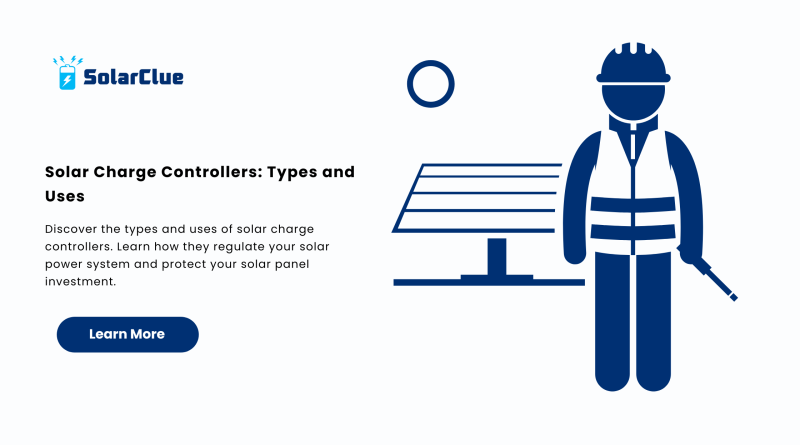Solar Charge Controllers: Types and Uses
Every efficient solar power system relies on a small but crucial device—solar charge controllers. Whether you’re building a simple residential solar kit or a complex off-grid system, choosing the right charge controller ensures safety, performance, and longevity. In this guide, we’ll break down the types of solar charge controllers, how they work, and how to choose the right one for your system.
Table of Contents
- 1 What Are Solar Charge Controllers?
- 2 Why Are Charge Controllers Important?
- 3 Types of Solar Charge Controllers
- 4 How to Choose the Right Charge Controller
- 5 Top Solar Charge Controller Brands in India
- 6 Installation Tips
- 7 Common Mistakes to Avoid
- 8 Real-Life Example
- 9 Maintenance Guide
- 10 Environmental Impact
- 11 FAQs
What Are Solar Charge Controllers?
A solar charge controller is a regulator that manages power flow between a solar panel, battery, and inverter. It prevents battery overcharging, regulates voltage, and protects your solar power system from damage. Without it, you risk battery failure and energy losses.
There are two main types of solar charge controllers—PWM (Pulse Width Modulation) and MPPT (Maximum Power Point Tracking). Both serve the same basic purpose but differ in efficiency, cost, and use-case.
Why Are Charge Controllers Important?
- Prevent overcharging and battery damage
- Optimize solar panel output
- Improve battery lifespan
- Enhance overall solar power system efficiency
Whether you have a rooftop solar kit or a large-scale solar power system, a charge controller is a must-have.
Types of Solar Charge Controllers
1. PWM (Pulse Width Modulation)
PWM solar charge controllers are older and more affordable. They gradually reduce power from the solar panel as the battery gets full, maintaining safe voltage levels. Ideal for:
- Small-scale solar power setups
- Low-budget systems
- Lead-acid batteries
Pros:
- Cost-effective
- Simple design
- Reliable for basic setups
Cons:
- Lower efficiency (70–80%)
- Not suitable for large systems
2. MPPT (Maximum Power Point Tracking)
MPPT solar charge controllers are advanced and extract maximum energy from your solar panel by tracking the panel’s optimum voltage. They work well even in cloudy weather.
Best for:
- High-end residential and commercial setups
- Lithium-ion and gel batteries
- Locations with variable sunlight
Pros:
- High efficiency (90–98%)
- Suitable for large and complex solar power systems
- Better return on investment
Cons:
- More expensive
- Needs proper configuration
How to Choose the Right Charge Controller
Battery Compatibility
Ensure your controller supports your battery type—lead-acid, lithium-ion, or gel.
Voltage Rating
Common system voltages are 12V, 24V, or 48V. Match this with your solar panel and battery.
Current Rating
Choose a charge controller with 25% more current capacity than your panel’s output.
Budget and Scalability
While PWM is cheaper, MPPT gives long-term savings with higher efficiency and scalability.
Top Solar Charge Controller Brands in India

Loom Solar
Offers both PWM and MPPT models with digital display and mobile app support.
Sukam
Known for durable and budget-friendly PWM controllers.
Microtek
Delivers hybrid MPPT controllers ideal for Indian conditions.
Victron Energy
High-end brand with advanced MPPT tracking algorithms and Bluetooth monitoring.
Luminous
Trusted for residential solar kits with in-built charge controller options.
Installation Tips
- Mount the controller near the battery for voltage accuracy.
- Keep it in a cool, dry place.
- Use appropriate gauge wires to handle current.
- Avoid mixing different panel wattages.
- Read the instruction manual for connection sequence.
Common Mistakes to Avoid
- Using a PWM controller in a large solar power setup
- Skipping fuse protection
- Ignoring battery type compatibility
- Overloading the controller beyond its current rating
Real-Life Example
Ravi, a small shop owner in Jharkhand, upgraded his rural store’s 500W solar power system with an MPPT charge controller from Victron. Within a month, he noticed improved lighting hours, battery longevity, and better performance during cloudy days. His story is a strong case for choosing the right solar charge controller.
Maintenance Guide
- Check LED display or app regularly
- Tighten connections monthly
- Clean the unit with a dry cloth
- Inspect for corrosion or damage every quarter
Environmental Impact
By using solar charge controllers, we prevent energy waste, reduce battery replacements, and make solar energy use more sustainable. Efficient energy regulation means longer-lasting batteries and less e-waste.
FAQs
1. What does a solar charge controller do?
It regulates energy from the solar panel to the battery.
2. Which is better—PWM or MPPT?
MPPT offers higher efficiency but is costlier. Choose based on system size and budget.
3. Do I need a charge controller for every panel?
No, one controller can manage multiple panels if rated correctly.
4. Can I use a charge controller without a battery?
No. It is meant to protect batteries.
5. Does it work in monsoon?
Yes, especially MPPT models which adjust to variable sunlight.
Understanding solar charge controllers is essential for optimizing your solar power system. Whether you’re powering a cabin, home, or school, the right controller can make or break your system’s efficiency. Ready to pick the best one? Browse top brands and expert guides at solarclue.com and check out the latest trends on blog.solarclue.com—your solar journey deserves the right start.


